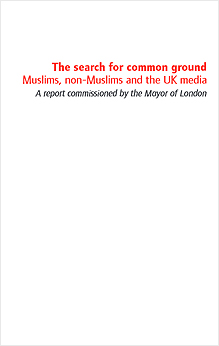
Publisher: Greater London Authority
Release Date: November 2007
Pages: 180
Source: http://www.insted.co.uk/search-for-common-ground.pdf
This is the second of two pioneering reports prepared as a result of initiatives of the Mayor of London, Ken Livingstone. The ‘Muslims in London‘ report published in 2006, provided the first systematic use of data from the 2001 Census to build a detailed profile of Muslim communities in the capital city. This second systematic study was commissioned by the Mayor to examine media coverage of Islam and Muslims. The investigation was coordinated by Angela Gluck Wood and Robin Richardson, and among other contributors are Christopher Allen, author of ‘Islamophobia in the European Union after 11 September 2001, Hugh Muir of The Guardian and Laura Smith (both joint authors with Robin Richardson of ‘Islamophobia: Issues, Challenges and Action – A Report by the Commission on British Muslims and Islamophobia Research (2004).
The research was carried out between May 2006 – April 2007, a time when topical issues included the Danish Cartoon controversy, the Jack Straw veil remarks , the lecture by the Pope quoting a 14th century Christian emperor who said the Prophet of Islam, had brought only ‘evil and inhuman things’ to the world, the Channel 4 Dispatches documentary disparaging so-called ‘Wahhabi’ mosques, the ongoing wars in Iraq and Afghanistan and a statement by the head of MI5 about the dangers from Muslims in Britain. The resulting media coverage of some of these issues is examined by the authors.
The report includes the findings of a quantitative study of how Islam and Muslims were represented in the British press during one week – 8th to 14th May 2006, detailed analysis of four episodes involving serious factual inaccuracies and distortions (including images of the sensationalist media headlines), interviews with six Muslim journalists to explore how they cope professionally, and a case study based on the notorious BBC Panorama programme prepaed by John Ware, ‘A question of leadership’ (August 2005).
The quantitative study found 352 articles that referred to Islam and Muslims during the week in question, “91 per cent were judged to be negative in their associations, and only four per cent were judged to be positive…in the tabloids, 96 per cent of all articles were judged to be negative. This compared with 89 per cent of broadsheet articles. The combined circulation of the tabloids is about three times greater than that of the broadsheets (May 2007 figures). It was judged that almost half of all articles represented Islam as a threat. Of these, about a third pertained to Britain and two-thirds to the wider world. The overall picture presented in the national press during the week in question was that on the world stage Islam is profoundly different from, and a serious threat to the West; and that within Britain Muslims are different from and a threat to ‘us’.”
These are sobering findings, given that 64% of the population admit they ‘do not know very much’ about Islam, while 66% get their information from media and television! [ ‘Attitudes towards British Muslims, Yougov poll, 2002 commissioned by the Islamic Society of Britain for Islam Awareness Week, 2002]
Two of the six Muslim journalists interviewed observed that they were expected “to use any wiles they could in order to get the story, including their ethnic or religious identity….at least two had been asked, as a professional assignment, to infiltrate al-Qaeeda”! Another Muslim reporter noted, “after one of the terrorist attacks I was sent to door-knock a suspected extremist. The office knew it was a long shot but I was quite determined and I knew my Muslim background could get me in. I knocked on the door and said Assalamu Aleikum and told them I was a Muslim. After a few minutes they let me in. I was a journalist just beginning. I would have done the story very differently now but I didn’t know what the paper was looking for then. I just took what he was saying at face value. What I wrote was exactly what he had told me without any slant on it. It was neutral…..the next day I looked at the paper and I was appalled. It had been rewritten in a way that made him really slippery. It was really cynically done…I felt very guilty because I was complicit in stitching him up”.
The report concludes with a discussion on the notion of ‘moral panic’ – the construction of folk devils seen as the embodiment of all that is negative, deviant and evil – and it asks, “to what extent and what ways are Muslims the latest incarnation of folk devils in a lineage which since the 1950s has included also teddy boys….Afro-Carbbeans, welfare scroungers, dangerous dogs…?”.
The report’s recommendations include – optimistically – the plea for news organisations “to review their coverage of issues and events involving Muslims and Islam, and for codes of professional conduct and style guides about use of terminology”. The guidelines on racist reporting issued by the National Union of Journalists form a model.
Much is made of the free media in Britain, but in practice content is shaped the prejudices of a handful of media barons – Richard Desmond (Express, Sunday. Express and Daily Star) and Rupert Murdoch (Sun and The Times). At a trade union seminar in February 2008, Tim Lazard of the NUJ, described the shop floor actions of workers at the ‘Daily Star’ who held up a production run because of outrageously Islamophobic content – including a ‘Page 3 burqa babes special’ and other mocking comments on the shariah. Apparently the original ideas for the story line had come from the very top.
